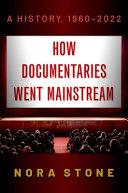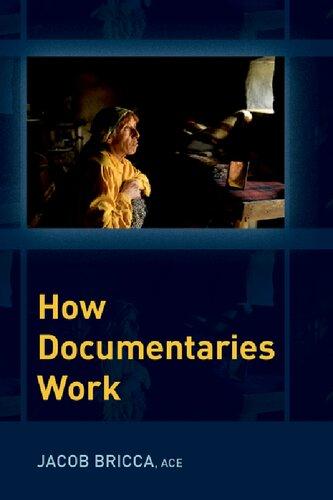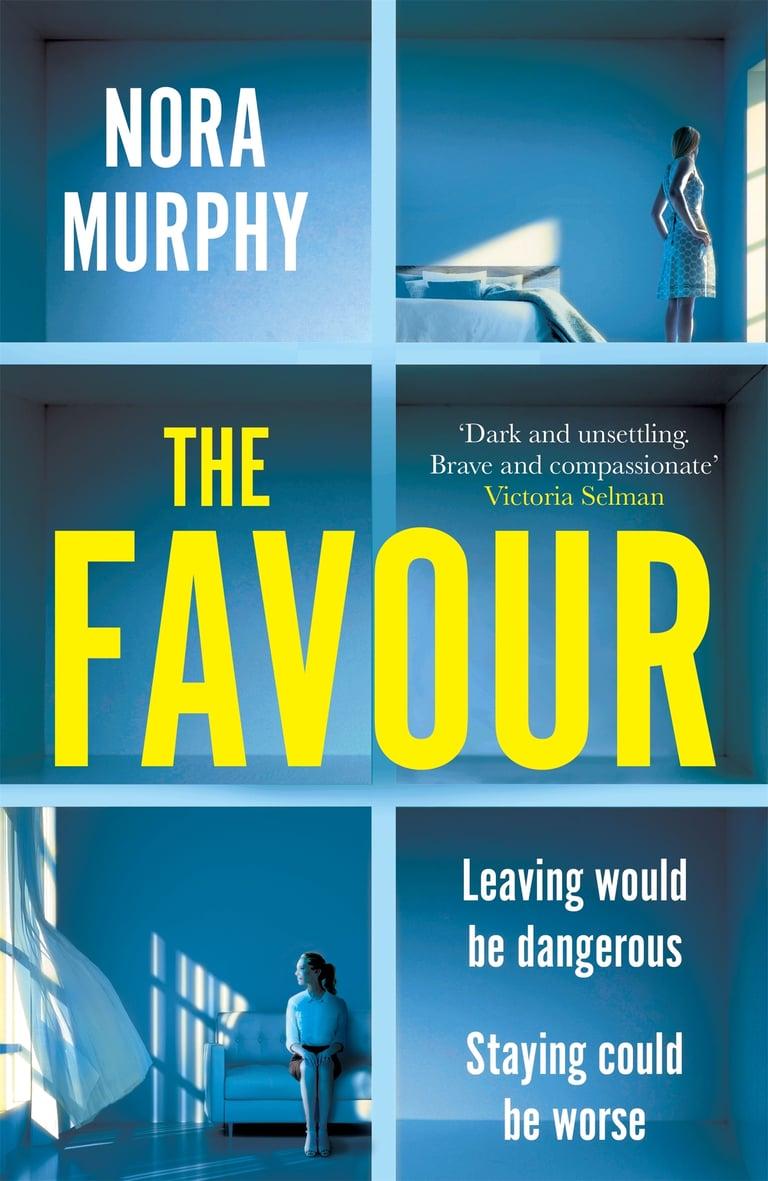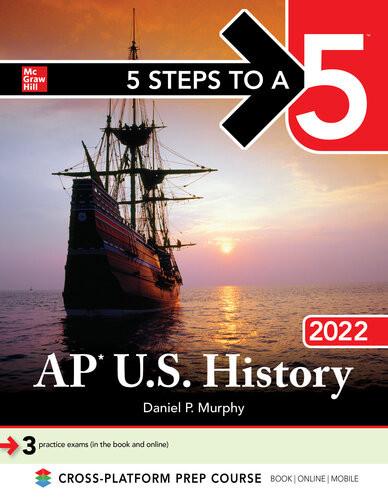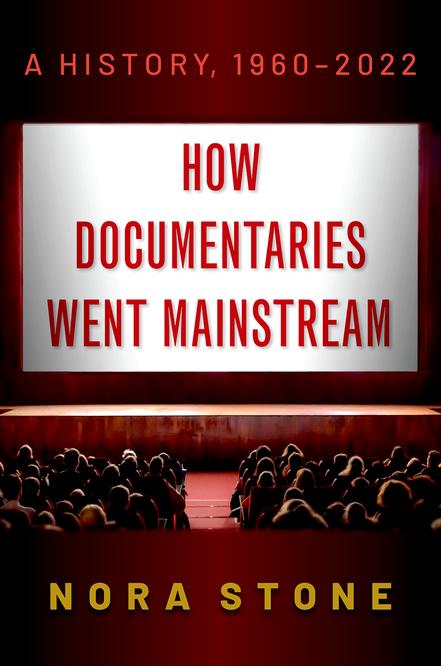Introduction
How Documentaries Went Mainstream
Documentary feature films have historically existed on the margins of mainstream media. In the United States, enterprising documentarians have spent most of the past sixty years struggling to find a larger, broader audience for their films. Often negatively associated with long-form television journalism and tedious educational programming, documentaries have rarely escaped their perceived status as “cultural vegetables”—good for you, but relatively unappealing. Recently, this marginal status has shifted quite dramatically. Nearly unthinkable a decade ago, documentary films have become reliable earners at the US box office. In 2018 alone, Won’t You Be My Neighbor? made almost $23 million, They Shall Not Grow Old and Free Solo each earned almost $18 million, RBG netted $14 million, and Three Identical Strangers earned $12 million. In addition to their theatrical presence, documentary films are ubiquitous on cable channels and streaming video services, which have made documentary programming a key component of their offerings to subscribers. In 2019, Netflix paid the highest price for a documentary out of the Sundance Film Festival: $10 million for Knock Down the House, about four working-class women, including Alexandria Ocasio-Cortez, running for Congress in the 2018 midterm elections. Longtime documentary champion and former head of HBO Documentary Sheila Nevins said that Netflix was playing with “Monopoly money” by acquiring the documentary at such a high price, but she also granted that this was a trend across the board.1 Industry journalists took note. This surge in popularity had made documentaries nearly ubiquitous. In 2019, think pieces from CBS News, NPR, the Los Angeles Times, and The Ringer all simultaneously proclaimed a new golden age of documentary.2 With broad public interest and robust
1 Mandalit del Barco, “The Documentary Is in—and Enjoying—an ‘Undeniable Golden Age,’” NPR.org, February 19, 2019, https://www.npr.org/2019/02/19/696036323/the-documentary-is-inand-enjoying-an-undeniable-golden-age
2 “The Golden Age of Documentary Filmmaking,” CBS News, March 3, 2019, https://www.cbsn ews.com/news/the-golden-age-of-documentary-filmmaking/; del Barco, “The Documentary
How Documentaries Went Mainstream. Nora Stone, Oxford University Press. © Oxford University Press 2023. DOI: 10.1093/oso/9780197557297.003.0001
investment in their production, documentary films are definitively more popular and prestigious than ever before.
Although the commercial ascension of documentary films might seem meteoric, it is the culmination of decades-long efforts on the part of innovative, intrepid filmmakers; risk-taking, often socially committed distribution companies; and institutions like public television stations, cable networks, film festivals, and contemporary streaming services that have developed and fortified the audience for documentary features. The commercialization of documentary filmmaking has transformed it into a media sector that promises sufficient financial stability and growth potential to attract sizable, consistent private investment—a remarkable inflection point in a history alternately defined by scrappy entrepreneurs and nonprofit advocates.
Three core tensions recur in this history. The first is documentary film’s dual foundation in the worlds of television and cinema. Television has been a persistent funding source and exhibition outlet for documentary films over the past sixty years, but this association has, at times, prevented documentaries from being seen as vital, engaging cinema. Releasing a film in theaters keeps it in the media cycle for a longer period than does a television broadcast, allowing it to accrue more reviews from critics, features from journalists, and word of mouth from audiences. Labeling a documentary a “film” also conveys a higher level of prestige and import. These differences in release structure and perception have contributed to documentary film’s commercial and discursive transition.
The second core tension is between the isolated entrepreneur and the organized institution. No matter the broader landscape for documentary, there are filmmakers who do whatever it takes to make documentaries and bring them to viewers—they fund production with personal favors and credit cards, self-distribute their work, form distribution collectives, publish films for free streaming over the internet. As documentary films’ commercial potential and connection with the commercial media industry have grown, so too have the number of commercial and nonprofit entities invested in them. It may appear that these institutions would eliminate the need for activist, entrepreneurial documentarians, but this development has in no way sidelined them. Instead, their persistent presence over time demonstrates
Is In”; Amy Kaufman, “‘Three Identical Strangers,’ ‘RBG’ Directors and Others Look Back on Documentary’s Big Year,” Los Angeles Times, January 4, 2019; Sean Fennessey, “We Are Living through a Documentary Boom,” The Ringer, July 24, 2018.
that documentary retains a grassroots spirit and a connection to maverick American independent cinema.
Finally, and most crucially, there is the ambiguity surrounding what the “market” for documentary films even is or should be. This tension extends throughout the history of documentary film in the United States and strikes at the heart of the difficulty of tracing documentary film’s commercialization. For documentary films, there is more to the market than a rationalized system of commodity exchange. The feature documentary market has a parallel and symbiotic element to it: the concept of public service. Some agents of this market, like distributors, are explicitly interested in documentary features as commodities that can be exchanged for profit like fiction features. Other agents, like government agencies, public broadcasters, and nonprofit organizations, are more interested in producing and circulating documentary features as a form of public service—a way to promote alternative ideas and cultural forms. Documentary filmmakers come to the market with a mix of these goals and must navigate each stage of the documentary world with an eye toward often-contradictory principles and imperatives. The intertwining of commodity exchange and public service is especially tight once a film begins to circulate through various exhibition sites and windows; documentaries supported by grants or by public TV, for instance, increasingly circulate through commercial spaces like theaters and streaming services.
The commercialization process traced in the book is not separate from, nor does it replace, the public service element of the documentary film market. Rather, the balance between these elements has changed over time. The public service aspect of documentary film has been diluted, compared to the 1960s and 1970s, but is still present and significant. Currently, the most commercial documentary films are generally apolitical and barely invested in public service, if at all. For example, see the recent theatrically released documentaries Biggest Little Farm (2019) and Apollo 11 (2019), and documentaries popular on streaming services, Miss Americana (2020) and Tiger King: Murder, Mayhem, and Madness (2020). Barring a handful of exceptions, this has always been the case. But the public service element of documentary film still benefits from ballooning interest and investment in popular documentary forms. The commercialization of documentary film has expanded the audience size of documentaries, making them broadly accessible in more entertainment-oriented venues, like movie theaters, cable television, and streaming services.
Explaining the Commercialization of Documentary
This book enriches the history of documentary film by foregrounding production funding mechanisms, distribution norms, and discourses, with a resulting greater explanatory power. In extant studies, there has been little attention to how industrial and institutional changes affect what documentary films are made and which audiences view them. Instead, chronological histories often highlight major film movements and trumpet stylistic advances.3 Such scholarship traces crucial developments in the art of documentary film, but it suggests little about how documentarians related to the broader world of commercial media. At the same time, most histories of American cinema and television barely gesture to documentary film, because documentary’s commercial and cultural significance is presumed to be insignificant in comparison to Hollywood tentpole films or even indie fiction films. This history concentrates on documentary film industry and institutions in order to account for both extraordinarily successful documentaries that break into the zeitgeist and the simultaneous persistence of conventional films and release strategies. Drawing on archival documents, interviews with filmmakers and film distributors, industry trade journals, and popular press, the book illuminates how documentary features have become more plentiful, popular, and profitable than ever before.
This work joins histories that clarify the material conditions affecting how documentary films are made and what happens when audiences encounter them. Much recent scholarship has analyzed the activist power of documentary film in the networked media age.4 These authors discuss how the affordances of streaming video and online community have allowed people to form communities and take action based on documentary film. But the commercial valance of many films and distribution platforms goes unexplored. In this way, the public service value of documentary film, particularly political documentary, has received far more scholarly attention than the commercial side. Texts on individual documentarians offer hints about the
3 Stephen Mamber, Cinema Verite in America: Studies in Uncontrolled Documentary (Cambridge, MA: MIT Press, 1974); Richard Barsam, Nonfiction Film: A Critical History, Revised and Expanded (Bloomington: Indiana University Press, 1992); Betsy McLane, A New History of Documentary Film, 2nd ed. (London: Continuum, 2012).
4 Angela Aguayo, Documentary Resistance: Social Change and Participatory Media (New York: Oxford University Press, 2019); Caty Borum Chattoo, Story Movements: How Documentaries Empower People and Inspire Social Change (New York: Oxford University Press, 2020); Tanya Horeck, Justice on Demand: True Crime in the Digital Streaming Era (Detroit: Wayne State University Press, 2019).
documentary film market. For example, David Resha’s The Cinema of Errol Morris and multiple essays in Jeff Jaeckle and Susan Ryan’s edited collection ReFocus: The Films of Barbara Kopple discuss how filmmakers financed and distributed their productions.5 But an account of the wider system and its change over time remains elusive.
This history is attentive to the transmedia relationships that supported and grew the commercial potential of documentary film. While academic areas divide up the study of particular media, documentary filmmakers cannot isolate themselves to a single medium; they must consider and navigate the whole documentary ecosystem.6 Consequently, the book illuminates networks of production and circulation that transcend conceptual categories, like film and television, commercial and nonprofit media, theatrical distribution and nontheatrical circulation. It identifies key institutions for documentary film that have not been clearly identified or related to one another before. Highlighting transmedia means I elaborate the history not only of documentary film, but also cable television, public television, home video, and video streaming services. To help me triangulate the place of documentary film in the commercial media industry, I rely on texts that trace shifting industrial logics and those that foreground agents like festival programmers, film distributors, and television and streaming service executives.7
5 David Resha, The Cinema of Errol Morris (Middletown, CT: Wesleyan University Press, 2015); Jeff Jaeckle and Susan Ryan, eds., ReFocus: The Films of Barbara Kopple (Edinburgh: Edinburgh University Press, 2019). Other examples include Douglas Kellner and Dan Streible, Emile de Antonio: A Reader (Minneapolis: University of Minnesota Press, 2000); P. J. O’Connell, Robert Drew and the Development of Cinema Verite in America (Carbondale: Southern Illinois University Press, 1992); Gary Edgerton, Ken Burns’ America (New York: Palgrave, 2001); Jonathan Vogels, The Direct Cinema of David and Albert Maysles (Carbondale: Southern Illinois University Press, 2005); Matthew H. Bernstein, ed., Michael Moore: Filmmaker, Newsmaker, Cultural Icon (Ann Arbor: University of Michigan Press, 2010); Keith Beattie, D.A. Pennebaker (Urbana: University of Illinois Press, 2011).
6 Los Angeles Documentary and the Production of Public History, 1958–1977, is a notable exception to this rule. The author explicitly shows the connections and the movement back and forth between television documentaries and alternate documentaries. Joshua Glick, Los Angeles Documentary and the Production of Public History, 1958–1977 (Berkeley: University of California Press, 2018).
7 Tino Balio, ed., Hollywood in the Age of Television (Boston: Unwin Hyman, 1990); Paul McDonald and Janet Wasko, eds., The Contemporary Hollywood Film Industry (Hoboken, NJ: WileyBlackwell, 2008); Marc Leverette, Brian L. Ott, and Cara Louise Buckley, eds., It’s Not TV: Watching HBO in the Post-television Era (New York: Routledge, 2008); Gary R. Edgerton and Jeffrey P. Jones, eds., The Essential HBO Reader (Lexington: University Press of Kentucky, 2008); Travis Vogan, “ESPN Films and the Construction of Prestige in Contemporary Sports Television,” International Journal of Sport Communication 5, no. 2 (June 2012), 137–52, https://doi.org/10.1123/ijsc.5.2.137; Yannis Tzioumakis, Hollywood’s Indies: Classics Divisions, Specialty Labels, and American Independent Cinema (Edinburgh: Edinburgh University Press, 2012); Alisa Perren, Indie, Inc.: Miramax and the Transformation of Hollywood in the 1990s (Austin: University of Texas Press, 2012); Dina Iordanova, “The Film Festival as an Industry Node,” Media Industries Journal 1, no. 3 (January 1, 2015), https:// doi.org/10.3998/mij.15031809.0001.302; Amanda Lotz, We Now Disrupt This Broadcast: How Cable Transformed Television and the Internet Revolutionized It All (Cambridge, MA: MIT Press, 2018);
In this book, I foreground distribution and circulation as the locus of meaning and value for documentaries. Centering distribution means attending to business strategy and changing delivery technology, as well as interrogating how commodity and public service value are invoked in different contexts. A number of texts published in the last fifteen years have attended to emerging distribution methods in the media industry, especially those that blur the boundaries between film and television. In Reinventing Cinema: Movies in the Age of Media Convergence, Chuck Tryon compares different services and practices of circulation in the digital era.8 Like Tryon, I attend to the interplay between circulation practices and the discourse surrounding a text, but I narrow my scope to one specific genre. Julia Knight and Peter Thomas’s Reaching Audiences: Distribution and Promotion of Alternative Moving Image shows how changes in public policy and technology affected alternative film distribution in the United Kingdom.9 The essays in Derek Johnson’s From Networks to Netflix: A Guide to Changing Channels detail television and video streaming services’ programming and branding strategies. This book is in conversation with the above by cutting across individual channels and services to show how documentary films have been used across the media landscape.10
The growing commercialization of documentary film has not gone unnoticed, but it has not been sufficiently explained. Journalistic accounts of documentary’s rise usually offer one or two causes—Netflix streaming and growing interest in reality TV and other stories about the real world. But these accounts, published consistently over the past twenty years whenever a documentary enters the cultural conversation or breaks a box-office record, do not grapple with the overlapping causal mechanisms that have commercialized documentary film. Nor do they offer meaningful periodization of the commercialization of documentary film, only a snapshot from an endless march of progress. I refine these rough accounts through a robust synoptic history of the market for documentary films, using knowledge of film
Patricia Aufderheide, “Documentary Filmmaking and US Public TV’s Independent Television Service, 1989–2017,” Journal of Film and Video 71, no. 4 (2021), 3–14.
8 Chuck Tryon, Reinventing Cinema: Movies in the Age of Media Convergence (Piscataway, NJ: Rutgers University Press, 2009).
9 Julia Knight and Peter Thomas, Reaching Audiences: Distribution and Promotion of Alternative Moving Image (Bristol: Intellect, 2011).
10 Derek Johnson, ed., From Networks to Netflix: A Guide to Changing Channels (London: Routledge, 2018).
economics and the norms of industry discourse to tell a richer story. This periodization will allow scholars to compare the commercialization of documentary film with other genres. It adds reference points to a complex history of change.
Moving chronologically, each chapter engages with a few significant elements of the documentary film ecosystem, including theatrical distribution, public television, cable television, film festivals, nonprofit and governmental granting agencies, home video, and video streaming services. Using individual films’ distribution histories as case studies, I analyze how these elements affected the commercialization of documentary film.
Chapter 1 covers 1960 to 1977, a time when the commercial possibilities for documentary film were being redefined. Television networks funded the production of documentaries, but Direct Cinema documentarian Robert Drew and his associates had ambitions beyond the scope of broadcast and the limits of journalism. They looked for a new context and new audiences for their work, and found it at film festivals, in experimental film culture, and, marginally, within the art-house film market. More successful on the art-house circuit were touristic documentaries like Mondo Cane (1963), which were marketed like the foreign films that dominated the art-house box office. Direct Cinema filmmakers finally hit upon a winning formula by making documentaries about popular music and youth culture, like Dont Look Back (1967) and The Endless Summer (1966). Simultaneously, politically committed filmmakers sought to circumvent the existing commercial infrastructure by creating their own collectives for producing and distributing alternative documentaries.
In Chapters 2 and 3, I contend with the two infrastructural anchors that increased the commercial value and cultural currency of documentary film in the 1980s: the rise and solidification of the American indie film movement and the maturation of the national Public Broadcasting Service. Chapter 2 explores how American independent film culture and institutions led to greater support for documentary film. New independent distribution companies and studio classics divisions acquired documentary films, particularly those with a music or performance element, like Say Amen Somebody (1982) and Stop Making Sense (1984). At the same time, documentarians extended the DIY practices of political filmmaking collectives by self-distributing their films, like Word Is Out (1978) The War at Home (1979), and The Atomic Cafe (1982). Chapter 3 traces how documentary filmmakers lobbied for access to PBS funding and airtime. While
PBS had some mechanisms for supporting documentary production, independent filmmakers used the community and institutions formed through the American indie cinema movement to fight for more. The result was funding through the Independent Television Service and regular airtime through P.O.V., both of which persist to this day.
Chapter 4 covers the 1990s, a period in which some documentaries, including Paris Is Burning (1991) and When We Were Kings (1996), earned higher grosses at the box office. But this escalation in commercial value led to a widening gap between powerful distribution companies that occasionally picked up documentaries and smaller distributors that distributed the majority of documentary films. The increasing commercial prospects also brought the conflict over documentary films as cinema or television to a head. The Academy of Motion Picture Arts and Sciences tried to enshrine the distinction with a rule change, decreeing that documentary films must have a regular theatrical release in order to qualify for Academy Awards nominations. This led to HBO shifting its strategy surrounding documentary films.
Chapter 5 details the “docbuster” era, a time of heightened visibility and popularity for documentary films. The years 2000 to 2007 saw a higher concentration of documentaries succeeding in theaters than ever before, with standouts like Fahrenheit 9/11 (2004), March of the Penguins (2005), and Capturing the Friedmans (2003). At the same time, the growth of the DVD market provided a new ancillary market for documentary films, and more cable television channels began funding the production of documentaries. While film festivals are often seen as a haven from the hypercommercial concerns of Hollywood, major film festivals became more imbricated with the industry than ever during this time.
The trend toward commercialization in the docbuster years intensified in the streaming era. Chapter 6 covers the contemporary moment, beginning in 2008. That year Netflix founded its streaming service and made documentary films a key part of its brand identity. This chapter explores how Netflix’s strategy around documentary shifted between 2008 and 2020. These shifts profoundly affected the documentary film industry—they drove production trends, caused filmmakers to adjust their mode of production, sent small theatrical distributors into a tailspin, and inspired numerous other streamers and portals to imitate Netflix’s strategy. With more outlets eager to acquire documentaries, the risk of investment lowered substantially, and companies began large-scale private investing in documentary projects for the first time ever.
1 Direct Cinema Blossoms, but Little Support for Documentary Films in Theaters (1960 to 1977)
Salesman (1969, dirs. Albert Maysles, David Maysles, Charlotte Zwerin) is a groundbreaking observational documentary film about door-to-door Bible salesmen. The film captures the mundane lives of the salesmen, nicknamed the Badger, the Bull, the Gipper, and the Rabbit, as they attend a sales team meeting, live in threadbare motel rooms, and knock on doors to sell expensive, illustrated Bibles. Shot on low-contrast 16 mm film, the mobile camera offers sincere, unflinching attention to men delivering sales pitch after sales pitch. The possibility of failure hangs over every interaction with those who open their door to the salesmen, building up suspense in each scene.
Salesman is recognized as a masterpiece, a revolutionary Direct Cinema film that showed how affecting a slice of life of ordinary people can be. The film was selected for the National Film Registry of the Library of Congress and parodied on the series Documentary Now! But the circumstances of Salesman’s production and circulation did not predict the esteem and influence the film would come to hold. Instead, the Maysles produced Salesman independently, at a budget between $100,000 and $200,000. They then formed their own distribution company to release the film. They premiered Salesman in New York City in April 1969, with a benefit for Cesar Chavez’s grape pickers union.1 They also sneaked the film onto television stations in other areas, in an effort to boost box-office returns. Salesman garnered rave reviews and played at prestigious festivals, including Berlin, Venice, and Mannheim. But the film was “relatively unsuccessful in limited playoffs in New York and other major cities,” according to Variety.2 After about seven
1 Kent E. Carroll, “Maysles Bros. Bible-Selling ‘Salesman’ Proves a Tough Sell for Producers,” Variety, April 16, 1969, 7.
2 “‘Salesman’ Rings Bell in Offbeat Playoff Dates,” Variety, November 12, 1969, 38.
How Documentaries Went Mainstream. Nora Stone, Oxford University Press. © Oxford University Press 2023.
DOI: 10.1093/oso/9780197557297.003.0002
months, the Maysles sold Salesman to a nontheatrical distributor, National Talent Service. NTS listed the rental for a $500 guarantee, plus $50 of the gate. The first nine months of Salesman’s nontheatrical release earned $50,000, while likely bearing lower overhead costs than a theatrical release would have.
Salesman’s release is emblematic of this period because the Maysles bought into the hopes for theatrical release of documentaries. But in the end, they sold the rights to Salesman to a nontheatrical distributor, tacitly acknowledging that the market did not yet support theatrical release of most documentary films.
The Fragmentary Market for Documentary Film
From 1960 to 1977 the commercial status of the feature documentary was radically redefined. Previously established types of documentaries, including newsreels and war documentaries, were essentially wiped out in the 1950s. US documentary production shifted almost completely to journalistic television. Some television documentarians, like Robert Drew and his associates, had larger ambitions. Their ideas and experiments exceeded the scope of broadcast and the limits of journalism, forcing them to find a new context and audience for their work. These Direct Cinema pioneers found such an audience at film festivals, in experimental film culture, and on the fringes of the art house market.
At the same time, one type of documentary film thrived in theaters: the touristic documentary. Films like Mondo Cane promised to shock and amaze viewers by showing exotic landscapes and lifestyles. Spectacle and titillation appealed to audiences, who bought tickets to see something they could not see on television. Direct Cinema documentaries also figured out a formula that attracted audiences: documentaries about popular music and youth culture. Film can capture musical performances with thrilling intimacy and aural fidelity, and in the 1960s and 1970s, documentarians harnessed this power in groundbreaking rockumentaries. To this day, documentaries about pop musicians, among other performers, are among the most commercially viable.
Although the trailblazing successes of films like Dont Look Back proved to be harbingers of future commercial strategies, they did little to address the distribution and exhibition challenges facing the numerous politically
oriented documentary filmmakers whose public-service agenda did not aim to replicate the profit-driven model of circulation. Instead, such filmmakers experimented with various models of self- and collective distribution by focusing their energies on nontheatrical exhibition within college campuses and along activist circuits. Without the spectacle of foreign sights or musical performances, there was little opportunity to generate interest for audiences.
Documentary on Television: Clip Shows, Investigative Journalism, and Observational Documentary
World War II was a significant time for documentary film in America. Major Hollywood directors like John Ford, Frank Capra, and William Wyler made documentaries about the war for the federal government.3 These and other documentary films were exhibited widely to American citizens and military personnel alike. In large cities, entire cinemas were devoted to showing newsreels and war-related nonfiction. But once the war was over, interest in documentaries shrank. At the same time, television began to broadcast news programs, which soon supplanted newsreels. The most highly regarded newsreel, March of Time, ceased production in 1951. And while schools and community organizations regularly rented nonfiction films, few documentaries were released theatrically.
The rapid spread of television and the growth of the television industry provided a substantial shift in the financing and exhibition of documentary media in the United States. Television became the center for nonfiction films. Throughout the 1950s, American television networks were reliable producers of news documentaries and nonfiction entertainment shows.4 But these documentaries and documentary series were made exclusively for television, and they had little contact with other exhibition contexts or with film culture.
Though live television was highly regarded during the medium’s first decade, American television networks soon sought to exercise more control and reap the financial rewards of syndication by producing prefilmed programs. Documentaries were a key part of that strategy. Television
3 The Battle of Midway (1942, dir. John Ford), Why We Fight (seven films, made between 1942 and 1945, dirs. Frank Capra and Anatole Litvak), Memphis Belle (1944, dir. William Wyler).
4 Michael Curtin, Redeeming the Wasteland: Television Documentary and Cold War Politics (New Brunswick, NJ: Rutgers University Press, 1995).
networks produced both hard-hitting journalistic shows like See It Now! and compilation-style documentaries about celebrities and history (Victory at Sea series [1952–53], Project XX [1954–62], Air Power [1956–57]). The typical journalistic documentary was anchored by a correspondent-host and covered a problem of national or international import. This correspondent introduced the episode’s topic, interviewed experts, and presented actuality footage. Produced by the network news divisions, journalistic documentaries were loss leaders, winning over critics but struggling to find both sponsors and audiences. On the other hand, the lighter fare was quite popular. Vance Kepley points out, “An NBC survey of Project XX’s commercial performance over its first decade indicated that the specials often generated strong ratings comparable to those of entertainment rather than public service programming.”5 While documentaries are often seen as sober affairs—the opposite of commercial television—nonfiction television programming incorporated a variety of tones, styles, and rhetorical strategies as early as the 1950s.6
The networks’ interest in documentary programming peaked in 1961 and 1962. Mounting criticism of quiz-show fixing and rampant commercialism led to threats of tighter regulations on the broadcasting industry. In order to maintain control, network heads met with Federal Communications Commission chairman John Doerfer as early as 1959.7 Both parties preferred self-regulation of broadcast television to further government interference, so they made a plan to demonstrate the networks’ willingness to correct course without new outside regulations. Under the Doerfer Plan, each network promised to air two hours of public service programming in prime time each week.8 Documentary was the primary vehicle for these aims. This briefly opened up opportunities for more independently made nonfiction
5 Vance Kepley Jr., “The Origins of NBC’s Project XX in Compilation Documentaries,” Journalism Quarterly 61, no. 1 (1984), 25.
6 This strategy continued in the 1960s, when independent producer David Wolper made numerous nonfiction series for syndication (Biography [1962] and The Story Of [1962]) and for national network broadcast (Hollywood: The Golden Years, Hollywood: The Fabulous Era, Hollywood: The Great Stars, made for NBC). Contemporary critic William Bluem observed, “Wolper found that there were some documentaries which networks, too, would carry—so long as they could be classed as ‘entertainment’ documentaries and thus not conflict with the networks’ direct supervision of their publicaffairs programming.” A. William Bluem, Documentary in American Television: Form, Function, Method (New York: Hastings House Publishers, 1965), 177. For more on Wolper’s work and how it shaped public history, see Joshua Glick, Los Angeles Documentary and the Production of Public History, 1958–1977 (Berkeley: University of California Press, 2018).
7 Curtin, Redeeming the Wasteland
8 James Lewis Baughman, “ABC and the Destruction of American Television, 1953–1961,” Business and Economic History 12 (1983), 62.
television, including the Drew Associates’ Direct Cinema documentaries that purposefully defied the conventions of television journalism.
In the early 1950s, Life magazine correspondent Robert Drew was looking for a way to make the filmic equivalent of Life’s photojournalism. In 1954, Drew made a pilot for NBC for a nonfiction series called Key Picture, but the network was unable to find a sponsor for this program, a prototype of the visually driven documentaries he would later make. Later in the decade, Drew took a different tack and convinced Time, Inc. / Life magazine to fund his filmmaking endeavors. The idea was that his documentaries would promote Life magazine, as the newsreel series The March of Time had done for Time magazine. With backing from Time, Inc., Drew put together a crew that included Richard Leacock—who had worked with Robert Flaherty—as well as younger filmmakers D. A. Pennebaker, David and Albert Maysles, and Hope Ryden.
Drew had limited success with his first documentaries. His early short efforts played on popular network television shows: Zero Gravity (1958) ran as a segment on the Ed Sullivan Show and on CBS News. Bullfight at Malaga (1958) was supposed to be a special on ABC, but because ABC affiliates worried about the violence toward an animal, a shortened version ran as a segment on the Tonight Show on NBC. None of the early Drew programs gained much attention or critical acclaim; it seemed Drew’s idea for candid film journalism might die on the vine. Drew Associates continued to make films with production financing from Time, Inc., but finding a consistent distribution and exhibition channel proved much more difficult. Even Primary (1960), the Direct Cinema classic that follows John F. Kennedy and Hubert Humphrey as they battle for Wisconsin in the Democratic primary, passed without support from the networks or notice from critics. While it is now considered a landmark documentary, none of the three national networks broadcast the film. Instead, a few stations owned by Time-Life and RKOGeneral, as well as some independent stations, broadcast the film in major cities.
Despite the paltry showing of Primary, Drew had better luck selling his next ideas to the networks for national broadcast. Drew produced On the Pole (1960) as a sports special for CBS. Then ABC hired Drew Associates to make episodes of its documentary series Close-Up! Because its news department was understaffed and lacked a well-known correspondent to host its series, ABC turned to outside producer Drew to supply episodes for CloseUp! This decision incensed the head of ABC’s news department, who thought
it wrong to surrender editorial control to an outside producer. Here the question about what Drew was making came into sharp relief: were the films journalism, or were they something else? Drew trained as a journalist at Life magazine and in the Nieman Fellowship at Harvard University, but he and his associates worked independently of the networks’ news divisions. They purposefully defied the conventions of network news documentaries, like reporters’ voice-over narration and interviews with experts, by employing an observational style. Yet they relied on the television networks to broadcast their work. This struggle for independence and access to the airwaves would continue, even after Drew Associates dissolved.
Soon the early members of Drew Associates broke off to form their own production entities. Many figures now celebrated as indisputably innovative pioneers of Direct Cinema continued in vain to try to work with networks. Ricky Leacock and Joyce Chopra made Happy Mother’s Day in 1963, for ABC. However, sponsors rejected it, and the network reedited it before air. Granada TV, a British television production company, commissioned David and Albert Maysles to make What’s Happening: The Beatles in the USA. When Granada licensed it to CBS, the network edited it and added narration by Carol Burnett. Later in the decade, D. A. Pennebaker and Ricky Leacock made Monterey Pop with backing from ABC. However, the network decided not to air it, so the filmmakers bought the rights from the network and distributed it through their theatrical distribution company. Though Direct Cinema pioneers were consistently frustrated by their dealings with American television networks, by the end of the 1960s, the former Drew Associates would forge the theatrical market for documentaries.
Feature Documentaries and Film Culture
Certain organizations and cultural movements set the stage for documentaries to grow in status and interest in the 1960s. Cinema 16, a film society based in New York, fostered cinephilia in the postwar years. Increased interest in foreign films swelled the number of distributors handling alternative films and screens exhibiting them. Finally, a number of American filmmakers, including former Drew Associates and critics, formed a community that would welcome the documentarians working in the next decade.
Cinema 16 was an important legitimizing outlet for documentaries, programming and exhibiting them alongside the most prestigious cinematic
fare. Incorporated in 1947, this nontheatrical club’s regular series and special programs created an eclectic context where documentaries were shown alongside classic, foreign, and experimental works. Cinema 16 also sent out programs of work to film societies (distribution began in 1948). Though it is better remembered for circulating avant-garde films and fostering cinephilia around classic Hollywood studio films during the 1950s, documentaries were central to its mission. In addition, Robert Flaherty, the father of American documentary film, helped with the club’s initial membership drive. Some Cinema 16 programs were all documentaries, such as the June 1950 program “Film and Reality,” described in the program notes as “A history of the documentary film as shown in the works of Sergei Eisenstein, John Grierson, Andre Gide, Jean Vigo, Robert Flaherty, Jean Painleve, Pare Lorentz, Louis de Rochemont, and accompanied by an authoritative commentary. Selected by Alberto Cavalcanti (Dead of Night).”9 Cinema 16 also showed individual contemporary documentaries, like The Quiet One (1948, dir. Sidney Meyers), shown 1952–53, and All My Babies (1953, dir. George Stoney) shown in early 1953. In May 1953, “A Program of Restricted Nazi Propaganda Films,” with special permission from the Department of Justice, played The Triumph of the Will (1935, dir. Leni Riefenstahl). Cinema 16 programmed a wide range of documentaries, ranging from the darkest uses of documentary—Nazi propaganda—to the newest documentaries, both experimental and educational. In so doing, the club promoted the idea that documentaries were worthy of inclusion in film culture.
The fate of documentary film in the United States—as well as the fate of Cinema 16—was linked to the success of imported foreign films. The foreign film market boomed following the war; 1950 to 1966 was the commercial heyday of foreign films in America.10 Independent companies, including Embassy, Continental, Films of the World, and Times Film, had been importing foreign films since 1946, bringing Italian neorealist films, British New Wave films, and the films of Ingmar Bergman to art house audiences in the United States. By 1957, the market had grown so much that the major studios entered, throwing their weight behind promising European auteurs with production financing deals. At the same time, the venues for showing
9 Program Notes, Spring 1950, in Scott MacDonald, Cinema 16: Documents toward a History of the Film Society (Philadelphia: Temple University Press, 2002), 141–43.
10 Tino Balio, The Foreign Film Renaissance on American Screens, 1946–1973 (Madison: University of Wisconsin Press, 2010).
foreign films grew greatly in number. By 1962, there were at least forty art houses in Manhattan alone.
The boom in foreign films demonstrated the commercial potential of an untapped market. As a result, revival houses opened, expanding the art house market and displacing cine-clubs like Cinema 16. There were three revival houses in Manhattan in 1961 and eleven by 1971.11 James Kreul points out that “Cinema 16’s demise was not precipitated by the creation of the Film-Makers’ Cooperative, but by the development of commercial revival houses such as [Lionel] Rogosin’s Bleecker Street Cinema and [Daniel] Talbot’s New Yorker Theatre.”12 These revival houses took over the function of Cinema 16, including showing documentary features on occasion. In addition, the people who ran them and other art houses also founded distribution companies that helped stimulate the market for documentary films.
At the same time that art house exhibitors expanded the number of venues in which documentaries could play, a new independent film movement was growing—creating a new context for documentary films. In response to the widespread interest in and admiration of foreign films in the United States, American filmmakers and critics felt a need to promote an alternative to the films associated with the Hollywood studio system. In 1960, several independent filmmakers wrote and signed a manifesto: the Statement of the New American Cinema. These were mainly narrative and avant-garde filmmakers, but documentarians Emile de Antonio and Shirley Clarke were part of the group as well. The New American Cinema movement, nourished by journals like Film Culture and the first New York Film Festival in 1963, helped incubate American cinephilia and provided a structure through which new independent filmmakers could gain guidance and exposure. These institutions and conditions paved the way for documentary cinema to thrive in various arenas during the 1960s and 1970s.
While the Direct Cinema documentarians struggled to gain more than a toehold in network television, film critics and cinephiles showed great interest in their work. This recognition helped their films move beyond the commercial world into the cinephilic cultural marketplace, where influential “buffs” praised them and proselytized for their methods. It was, in part, this recognition that aided Robert Drew’s associates and protégés to realize that
11 Balio, Foreign Film Renaissance, 247–48.
12 James Kreul, “New York, New Cinema: The Independent Film Community and the Underground Crossover, 1950–1970” (PhD dissertation, University of Wisconsin–Madison, 2004), 220.
their work need not be restricted by network television expectations, that they could gain ground in theaters or at least among college crowds. Though the Direct Cinema filmmakers were not signatories of the First Statement of the New American Cinema or members of the Film-Maker’s Cooperative, cinephiles’ admiration brought them into contact with the independent and avant-garde filmmakers who were establishing their own institutions. The risks taken by their enterprising peers undoubtedly set an example for those Direct Cinema filmmakers who would self-finance their documentaries and found their own distribution companies later in the decade. It added a huge amount of prestige as well, drawing the documentarians away from the lucrative, controlled, unfashionable network TV market and toward the hipper film festival and campus crowds.
In the summer 1961 issue of Film Culture, the editors announced that the makers of Primary Ricky Leacock, Don Pennebaker, Robert Drew, and Albert Maysles—had won the Third Independent Film Award. The editors (perhaps primarily Jonas Mekas) praised the film, as well as Yanki No! (1960), in glowing terms, calling it “a revolutionary step and a breaking point in the recording of reality in cinema.”13 They suggest that fiction filmmakers should take cues from Direct Cinema’s techniques, and compare the filmmakers’ accomplishments with those of past winners: “Shadows and Pull My Daisy have indicated new cinematic approaches stylistically and formally. Primary goes one step further: by exploring new camera, sound and lighting methods, it enables the filmmaker to pierce deeper into the area of new content as well.”14 This appreciation was prescient—later critics would admire Direct Cinema–style documentaries for the same reasons, both their innovative style and techniques, and the way that these techniques transformed the subject matter. By embedding with the subjects—folk singers, mental health institutions, youth gangs—these documentaries would take on more searing urgency, dovetailing with the politically volatile atmosphere.
Film festivals also put Direct Cinema filmmakers in closer contact with the thriving film culture of the New American Cinema movement. Drew Associates’ Crisis: Behind a Presidential Commitment and The Chair screened at the first New York Film Festival, before being broadcast on television.15 Other documentaries that played the first NYFF were picked up
13 “Third Independent Film Award,” Film Culture 22–23 (Summer 1961), 11.
14 “Third Independent Film Award,” 11.
15 ABC broadcast Crisis: Behind a Presidential Commitment a month after the NYFF, in October 1963.
by distributors for successful theatrical runs, including Emile de Antonio’s first documentary, Point of Order. After a short run via self-distribution in early 1964, foreign film importer Walter Reade-Sterling / Continental picked up Point of Order, made in conjunction with Dan Talbot of the New Yorker Theater and New Yorker Films. The surprise success of Point of Order, which is composed exclusively of black-and-white kinescopes of television footage of the 1954 Army-McCarthy hearings, likely burnished the theatrical potential of Direct Cinema documentaries, for both their makers and potential distribution companies.
In August 1964, the Venice Documentary Film Festival showed both Crisis and a short film Drew produced about Kennedy’s funeral, Faces of November In August 1964, closer to home, the Gallery of Modern Art in New York highlighted the Direct Cinema movement with a three-week series of films and a symposium. The museum established its “center for the viewing, study and encouragement of new movements in films” in July 1964; the Direct Cinema film series was its first program.16 The series included Primary, Showman, Lonely Boy, The Chair, David, Happy Mother’s Day, Georg, and The Quarters of Paris, all of which, it was advertised, had not yet been released commercially in the United States. It is significant that an art museum, founded by an heir to the A & P grocery fortune, would host such a celebration of this new style of documentary. Organized by James McBride, who would later play on cinéma vérité conventions in his directorial debut, the faux documentary David Holtzman’s Diary, the symposium hosted participants Richard Leacock, Jonas Mekas, James Lipscomb (a correspondent for Drew Associates), and Stanley Kaye (director of Georg).
Direct Cinema documentaries moved in and out of exhibition sites, from festival to TV to museum series. The struggles with television networks never ceased. When Time, Inc. terminated its contract with Drew Associates, after failing to find an outlet for The Living Camera, Drew came to understand that television networks would never welcome his independently produced film journalism.17 The Drew Associates disbanded.
16 “Gallery of Modern Art to Establish Film Center,” New York Times, July 23, 1964, 18. The next spring, in April 1965, the Gallery of Modern Art began daily showings of rare and classic films, including an unedited version of Un Chien Andalou, films by Jean Epstein and Dimitri Kirsanoff, and a retrospective on Hal Roach. Bosley Crowther, “Modern Art Gallery Sets Daily Showing of Classic Movies,” New York Times, April 19, 1965, 34. Further film programs included series of films by Busby Berkeley, Arthur Freed, Mervyn LeRoy, Stan Brakhage, and, later, sports documentaries and the Kennedy films made for TV by David Wolper.
17 As Drew explains, “Critically, the films were winning all kinds of awards and so forth. Breaking new ground. But the reason we made them was to try to establish a form of reporting which would
A few years later, in 1967, the NYFF programmed a significant series of American and Canadian documentary films. This was the first major documentary feature exhibition at the NYFF, and it garnered attention from audiences and critics alike. The success of this series helped a new era of potent social issue documentaries enter the cultural marketplace. It also represented a break with documentaries made earlier in the decade, when American television networks appeared to be a viable source of production financing and airtime. None of the documentaries at the NYFF were supported or had been broadcast by the networks; all were made independently, or under the aegis of the Canadian Broadcasting Corporation or National Educational Television, the precursor to the Public Broadcasting Service.
The NYFF had a major success with American feature documentaries. A Social Cinema in America series was separate from the main program, but by highlighting these documentaries and hosting panels with many of the filmmakers, the NYFF helped to create a recognizable context for them.18 In the runup to the festival, the New York Times dedicated column space to the series. Vincent Canby lavished praise on the films, describing their innovative nature. He wrote, “A preview of the program selections here yesterday revealed that socially and politically committed filmmakers are not only continuing to work with themes that most fiction filmmakers eschew, but that they are also working with an extraordinary new technical freedom permitted by the development of highly sensitive film, light-weight cameras and sound equipment. In all of the most effective films, the real-life characters speak for themselves. The day of the portentous voiceover narration is over.”19
pull audiences and pay for itself. So when Time, Inc failed to sell them and the contract went out, then that was the death of that idea—of trying that idea out. And the films were left—God, they were left to half-assed syndication and half-assed promotion and it was kind of a massacre.” “The Reminiscences of Robert Drew.” Seven interviews by Barbara Hogenson, October 4, 1979–April 23, 1980 (Oral History Research Office, Butler Library, Columbia University, New York, Mimeographed). Quoted in P. J. O’Connell, Robert Drew and the Development of Cinema Verité in America (Carbondale: Southern Illinois University Press), 165.
18 The films played in the Museum and Library of the Performing Arts, rather than in Philharmonic Hall. Tickets were free. Vincent Canby, “Films of Social Commitment Are Added to Festival,” New York Times, September 7, 1967, 51.
19 A number of the films dealt with the political and social questions of the day in a markedly more visceral and hard-hitting way than the journalistic television documentaries of the day. There were films about mental health and the elderly: Titicut Follies (dir. Frederick Wiseman), Warrendale (dir. Allan King), Home For Life (dirs. Gordon Quinn and Gerald Temaner). Others depicted turmoil within the civil rights movement and the problems faced by rural African Americans: Black Natchez (dirs. Ed Pincus and David Neuman), Now (dir. Santiago Alvarez Roman), Lay My Burden Down (dir. Jack Willis), Malcolm X (dir. Lee Bethune). Still others analyzed the Vietnam War and antiwar movement: Sons and Daughters (dir. Jerry Stoll), Mills of the Gods (dir. Beryl Fox), While Brave Men
